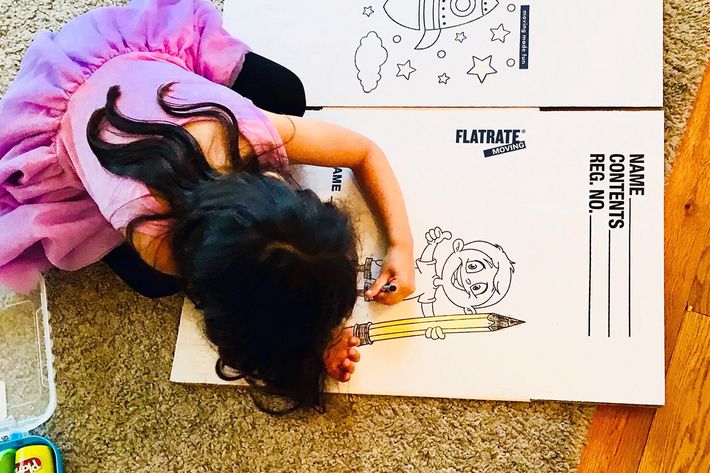
A brand-new apartment? Exciting! Having to pack your things and coordinate how to move into said apartment? Not so much. Moving is famously difficult and stressful, especially in New York City, where everybody could use a bit of help. We consulted two pros on how to make it as simple as possible, whether you’re moving into a studio or packing up kids’ rooms in your beautiful brownstone. Read on for insights from our moving experts, Manhattan-based Sharone Ben-Harosh, founder of FlatRate Moving, and Ann Lightfoot, a professional organizer at Done & Done Home.
1. Declutter before anything else
You don’t want to pay to schlep Aunt Linda’s hand-me-down quilt collection from one place to another if it’s just gathering dust in a cabinet. The best advice FlatRate has for saving money on a move is (perhaps unsurprisingly) to move less stuff. Before calling a company for a quote, and before putting anything in boxes, Lightfoot recommends going through every section of your place and setting everything on the floor. Only put back what you really want, need, or use. And be honest with yourself.
“It’s a couple stressful days, but it’s a big money saver when you don’t have to move stuff you don’t need, want, or use anymore,” Lightfoot says.
2. Always get a binding estimate from your movers
It makes good financial sense to seek a guaranteed price when you’re moving — to get a full rate for the job instead of an hourly rate — according to Ben-Harosh. Companies that don’t give out set rates “like for the move to take a little longer,” he warns, adding that he founded FlatRate Moving in 1992 because clients kept pushing for binding estimates instead of hourly fees. Moves are inherently complicated, and no one wants to pay for 12 hours after only planning (and budgeting for) a couple.
Related to this: when you’re getting the estimate, be as specific as possible with your moving company. Tell them about the peculiarities of your place, like that sofa with a wonky leg or the specific exit they’ll need to use to haul out your stuff. It’s important to tell them about pets, too, so they can send movers without allergies.
3. Be detailed when you pack
Since you’re only taking what you truly love (reminder: tip #1), you’ll want to make sure everything’s safe and easy to find when you arrive. Before the move, Ben-Harosh advises keeping a detailed inventory list and sharing it with your moving company. And then, really spend the time to pack valuables and fragile items carefully. FlatRate packs dishes vertically to help avoid breakage, for instance, and uses shrink wrap and blankets to cover sofas. Objects like TVs and lamps should have their own boxes — no exceptions.

Although you can ask your movers to pack for you, Lightfoot says you should definitely pack your own jewelry, cash, and other valuables, like passports, family heirlooms, and important files. If you’re boxing up everything yourself, you’ll also want a system where belongings for each room are clearly marked to show destination and contents. Lightfoot uses color-coded tape to show where each box will end up, whether in a specific room, a storage unit, a parent’s home, or somewhere else. Also, avoid common pitfalls like labelling boxes with vague names — for instance, “boy’s room” if you have more than one son.
4. Unpack your essentials first
It might seem counterintuitive, but the main thing to do when you arrive at your new place is get ready for bed. “The first thing you should unpack are your coffee, wine, and bed linens,” Lightfoot says. “Be prepared for those things so you have some reward at the end of the long day.” Ben-Harosh says you should also have a small box of essentials, with basics like cleaning materials, anything you need for your get-ready-for-bed routine, and your phone charger.
After that? Start with the kitchen, which Lightfoot says is the hardest, with all those gadgets and small items. And don’t be too hard on yourself for taking longer than you expect.
5. If you’re moving with children, have a clear plan
Should budgets and logistics allow, have the kids out of the house for the move: either at a friend’s house or with one parent while the other stays behind to pack and unpack. Or, have one room for the kids to play in while the rest of the moving is taking place. It helps keep the little ones’ stress levels at bay, and it’s easier for movers as they carry bulky and fragile objects.

To help kids feel like they’re part of the move, they can pack up their own rooms and paint the boxes (which will also make them easy to identify when you’re unpacking). If you’re in charge of the unpack, and the kids are out of the house, get their rooms settled before they arrive home. “Adults can deal with a change in place or schedule, whereas for the kids it’s a little bit harder,” Lightfoot says.
6. Be strategic about when you move
Ben-Harosh says that “planning ahead will help you avoid tough situations, which usually happen in the summer and the last day of every month when everybody needs to move.” If you can, try to avoid these high-traffic times, as you might end up sharing the elevator with other people (and their bulky couches). With some companies, you might have to pay more, too. Lightfoot adds that many people try to move on Fridays so that they can spread the work across the weekend, but she says an off-peak day like Thursday is better in case there’s a technical difficulty (broken elevator, faulty internet) that needs to be sorted out during business hours.
Got all that? Just remember our tips, and your next move will fly by — giving you plenty more time to enjoy your beautiful new place.
This is paid content produced for an advertiser by New York Brand Studio. The editorial staff of Daily Intelligencer did not play a role in its creation.




























